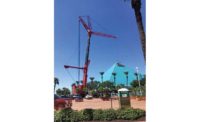The St. Louis Aquarium at Union Station
St. Louis
Best Project
Owner: Lodging Hospitality Management
Lead Design Firm: PGAV Destinations
General Contractor: McCarthy Building Cos.
Structural Engineer: Alper Audi Inc.
Civil Engineer: Frontenac Engineering
M/E/P Engineer: TJP Engineering
Excavation: Castle Contracting
Mechanical Contractor: Rock Hill Mechanical Corp.
Built within the footprint of the 1894 iron umbrella of historic Union Station, the St. Louis Aquarium is the centerpiece of a $187-million redevelopment of the National Historic Landmark structure. The 120,000-sq-ft, two-story aquarium has more than 13,000 animals, from 257 species, in 44 exhibits that provide visitors with perspectives of life in the world’s rivers, streams and oceans.
To deliver PGAV Destinations’ design vision for Lodging Hospitality, contractor McCarthy used 3D models that showed existing conditions with augmented reality overlays showing where mechanical piping, systems and the exhibits themselves would be. Revizto, a visual collaboration platform McCarthy used, allowed personnel to view the model on a tablet computer or even on their smartphones.
“There were no as-built drawings,” says Bryan Meyer, project director at McCarthy. “To put it all together, from a modeling standpoint, and use that software to kind of bring the project to life was the way to go. I don’t know how we would’ve done it without it.”
The project required the design and installation of 17 independent life support systems, tailored to accommodate the animal species that live in each exhibit. Carefully fabricated piping and salt and freshwater circulation systems had to be created underground, overhead and in the walls of the exhibits. Historic construction restraints on the 1894 train shed limited access to spaces that would house piping—sometimes allowing less than 2 ft of access space. The geotechnical team relied on maps to indicate details associated with the stacked limestone footings and timber pile foundations beneath the original structure. The team reused some of the existing foundations and installed an additional deep foundation micropile system capable of supporting the exhibits, pump rooms and systems.
“You look at people, process and technology—I think that we were very successful in bringing all three of those elements together to give the best product possible to our client and to these end-users so that the space is going to be able to be enjoyed by many [people] for many years to come,” says Alex Belcofer, VDC director at McCarthy.





Post a comment to this article
Report Abusive Comment